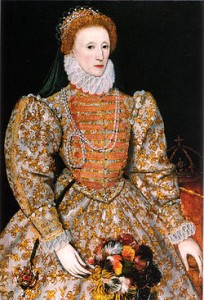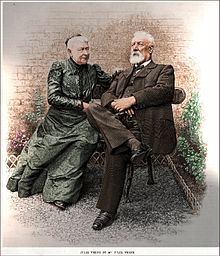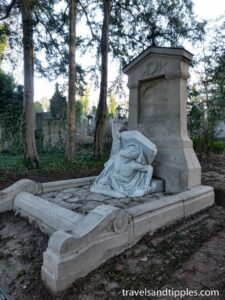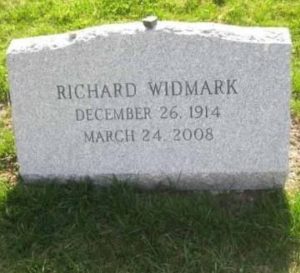On this day in 1603, Queen regnant of England and Queen regnant of Ireland from 17 November 1558 until her death, The Virgin Queen, Gloriana, Good Queen Bess, Elizabeth I died at Richmond Palace at the age of 69. Born in Greenwich Palace in the Chamber of Virgins on Sunday 7 September 1533, and named after both her grandmothers, Elizabeth of York and Elizabeth Howard. She was the second child of Henry VIII of England to survive infancy born in wedlock; her mother was Henry’s second wife, Anne Boleyn. Following the death of Henry on 28 January 1547, Elizabeth’s half-brother Edward VI would rule for six years until his death at the age of fifteen, Lady Jane Grey would rule for nine days and Elizabeth’s half-sister Mary I would rule for five years until her death at the age of 42. Elizabeth’s 44 year reign provided welcome stability for the kingdom and helped forge a sense of national identity. Elizabeth’s reign is known as the Elizabethan Era, famous above all for the flourishing of English drama, led by playwrights such as William Shakespeare and Christopher Marlowe. Elizabeth never married. Apparently she was in love with her childhood friend Lord Robert Dudley. Unfortunately due to the scandal surrounding the death of his wife, marriage to him was not possible. On her marital status she said; “If I follow the inclination of my nature, it is this: beggar-woman and single, far rather than queen and married”. And; “And, in the end, this shall be for me sufficient, that a marble stone shall declare that a queen, having reigned such a time, lived and died a virgin.” Elizabeth opposed a French presence in Scotland. She feared that the French planned to invade England and put her first cousin, Mary, Queen of Scots, who was Catholic and considered by many to be the heir to the English crown on the throne. When Mary was forced by the Protestant Scottish lords to abdicate in favour of her son James, Mary fled to England seeking the protection of Elizabeth. Perceiving her as a threat, Elizabeth had her arrested. After 19 years in custody in a number of castles and manor houses in England, she was tried and executed for treason for her alleged involvement in three plots to assassinate the queen. Elizabeth weathered the storm of religious division, surrounded herself with wise advisors who were dedicated to her, and used her own considerable political savvy, some would say luck, to become one the most beloved monarchs of all time. The impoverished and tattered country she had inherited had become one of the richest, most powerful nations in the world.
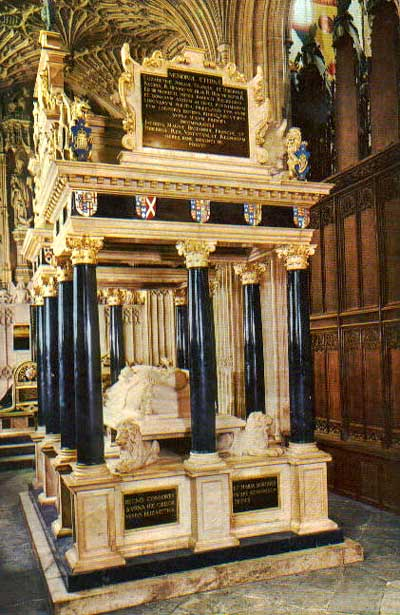 The Final Footprint – Elizabeth’s coffin was carried downriver at night to Whitehall, on a barge lit with torches. At her funeral on 28 April, the coffin was taken to Westminster Abbey on a hearse drawn by four horses hung with black velvet, where she was entombed. Her death marked the end of the Tudor dynasty. Many books and movies have featured Elizabeth, including Elizabeth (1998) and Elizabeth: The Golden Age (2007), both starring Cate Blanchett in the title role. She was nominated for an Academy Award for both films. The first film was nominated for best picture. Other notable Final Footprints at Westminster include; Robert Browning, Lord Byron, Geoffrey Chaucer, Oliver Cromwell, Charles Darwin, Charles Dickens, Edward The Confessor, George II, George Friederic Handel, Stephen Hawking, James I (James VI of Scotland), Samuel Johnson, Ben Jonson, Charles II, Edward III, Edward VI, Henry III, Henry V, Henry VII, Richard II, Rudyard Kipling, Henry Wadsworth Longfellow, John Milton, Sir Isaac Newton, Laurence Olivier, Henry Purcell, Mary I, Mary II, Mary Queen of Scots, Thomas Shadwell, Edmund Spenser, Lord Alfred Tennyson, Dylan Thomas, and William III.
The Final Footprint – Elizabeth’s coffin was carried downriver at night to Whitehall, on a barge lit with torches. At her funeral on 28 April, the coffin was taken to Westminster Abbey on a hearse drawn by four horses hung with black velvet, where she was entombed. Her death marked the end of the Tudor dynasty. Many books and movies have featured Elizabeth, including Elizabeth (1998) and Elizabeth: The Golden Age (2007), both starring Cate Blanchett in the title role. She was nominated for an Academy Award for both films. The first film was nominated for best picture. Other notable Final Footprints at Westminster include; Robert Browning, Lord Byron, Geoffrey Chaucer, Oliver Cromwell, Charles Darwin, Charles Dickens, Edward The Confessor, George II, George Friederic Handel, Stephen Hawking, James I (James VI of Scotland), Samuel Johnson, Ben Jonson, Charles II, Edward III, Edward VI, Henry III, Henry V, Henry VII, Richard II, Rudyard Kipling, Henry Wadsworth Longfellow, John Milton, Sir Isaac Newton, Laurence Olivier, Henry Purcell, Mary I, Mary II, Mary Queen of Scots, Thomas Shadwell, Edmund Spenser, Lord Alfred Tennyson, Dylan Thomas, and William III.
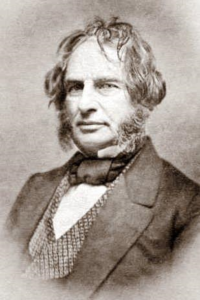 On this day in 1882, poet Henry Wadsworth Longfellow died from peritonitis at his home in Cambridge, Massachusetts, at the age of 75. Born on February 27, 1807 in Portland, Maine. His works include “Paul Revere’s Ride”, The Song of Hiawatha, and Evangeline. He was the first American to translate Dante Alighieri’s Divine Comedy and was one of the Fireside Poets from New England.
On this day in 1882, poet Henry Wadsworth Longfellow died from peritonitis at his home in Cambridge, Massachusetts, at the age of 75. Born on February 27, 1807 in Portland, Maine. His works include “Paul Revere’s Ride”, The Song of Hiawatha, and Evangeline. He was the first American to translate Dante Alighieri’s Divine Comedy and was one of the Fireside Poets from New England.
He studied at Bowdoin College and became a professor at Bowdoin and later at Harvard College after spending time in Europe. His first major poetry collections were Voices of the Night (1839) and Ballads and Other Poems (1841). He retired from teaching in 1854 to focus on his writing, and he lived the remainder of his life in the Revolutionary War headquarters of George Washington in Cambridge, Massachusetts. His first wife Mary Potter died in 1835 after a miscarriage. His second wife Frances Appleton died in 1861 after sustaining burns when her dress caught fire. After her death, Longfellow had difficulty writing poetry for a time and focused on translating works from foreign languages.
Longfellow wrote many lyric poems known for their musicality and often presenting stories of mythology and legend. He became the most popular American poet of his day and also had success overseas. He has been criticized by some, however, for imitating European styles and writing specifically for the masses.
The Final Footprint
On August 22, 1879, a female admirer traveled to Longfellow’s house in Cambridge and, unaware to whom she was speaking, asked him: “Is this the house where Longfellow was born?” He told her that it was not. The visitor then asked if he had died here. “Not yet”, he replied. In March 1882, Longfellow went to bed with severe stomach pain. He endured the pain for several days with the help of opium before he died surrounded by family. He had been suffering from peritonitis. He is entombed with both of his wives at Mount Auburn Cemetery in Cambridge, Massachusetts. Other notable final footprints at Mount Auburn include; Winslow Homer, Julia Ward Howe, Amy Lowell, Bernard Malamud, and Frances Sargent Osgood.
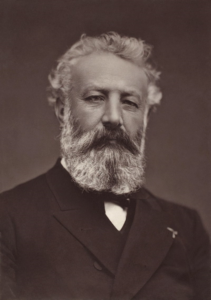
Photograph by Nadar c. 1878
On this day in 1905, novelist, poet and playwright Jules Verne died at his home in Amiens, 44 Boulevard Longueville (now Boulevard Jules-Verne) from diabetes at the age of 77. Born Jules Gabriel Verne on 8 February 1828 in Nantes, France.
Verne was trained to follow in his father’s footsteps as a lawyer, but quit the profession early in life to write for magazines and the stage. His collaboration with the publisher Pierre-Jules Hetzel led to the creation of the Voyages extraordinaires, a popular series of scrupulously researched adventure novels including Journey to the Center of the Earth (1864), Twenty Thousand Leagues Under the Sea (1870), and Around the World in Eighty Days (1873).
Verne has been the second most-translated author in the world since 1979, ranking between Agatha Christie and William Shakespeare. He has sometimes been called the “Father of Science Fiction”, along with H. G. Wells and Hugo Gernsback.
In May 1856, Verne traveled to Amiens to be the best man at the wedding of a Nantes friend, Auguste Lelarge, to an Amiens woman named Aimée du Fraysse de Viane. Verne, invited to stay with the bride’s family, took to them warmly, befriending the entire household and finding himself increasingly attracted to the bride’s sister, Honorine de Viane Morel, a widow aged 26 with two young children. Verne won the favor of Morel and her family, and the couple were married on 10 January 1857.
The Final Footprint
#RIP #OTD 1909 playwright (The Playboy of the Western World, Deirdre of the Sorrows), poet, Irish Literary Revival key figure, John Millington Synge died; Hodgkin lymphoma; Elpis Nursing Home, Dublin, aged 37. Mount Jerome Cemetery, Harold’s Cross, Dublin
#RIP #OTD in 1968 pioneer film director, one of the first filmmakers to make a narrative fiction film, as well as the first woman to direct a film, Alice Guy-Blaché died in a nursing home in Mahwah, New Jersey aged 94. interred at Maryrest Cemetery in Mahwah
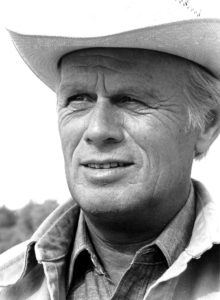 On this day in 2008 actor Richard Widmark died at his home in Roxbury, Connecticut, at the age of 93. Born Richard Weedt Widmark on December 26, 1914 in Sunrise Township, Minnesota.
On this day in 2008 actor Richard Widmark died at his home in Roxbury, Connecticut, at the age of 93. Born Richard Weedt Widmark on December 26, 1914 in Sunrise Township, Minnesota.
He was nominated for an Academy Award for his role as the villainous Tommy Udo in his debut film, Kiss of Death (1947), for which he also won the Golden Globe Award for Most Promising Newcomer. Early in his career, Widmark was typecast in similar villainous or anti-hero roles in films noir, but he later branched out into more heroic leading and supporting roles in Westerns, mainstream dramas, and horror films among others.
For his contributions to the motion picture industry, Widmark has a star on the Hollywood Walk of Fame at 6800 Hollywood Boulevard. In 2002, he was inducted into the Western Performers Hall of Fame at the National Cowboy & Western Heritage Museum in Oklahoma City, Oklahoma.
Widmark was married to screenwriter Jean Hazlewood from 1942 until her death in 1997. In 1999, Widmark married Susan Blanchard, the daughter of Dorothy Hammerstein and stepdaughter of Oscar Hammerstein II; she had been Henry Fonda’s third wife.
The Final Footprint
He was buried at Roxbury Center Cemetery.
 On this day in 2016, stand-up comedian, actor, director, writer, and producer Garry Shandling died in his home in Los Angeles, California at age 66 from a pulmonary embolism. Born Garry Emmanuel Shandling on November 29, 1949 in Chicago. Perhaps best known for his work in It’s Garry Shandling’s Show and The Larry Sanders Show.
On this day in 2016, stand-up comedian, actor, director, writer, and producer Garry Shandling died in his home in Los Angeles, California at age 66 from a pulmonary embolism. Born Garry Emmanuel Shandling on November 29, 1949 in Chicago. Perhaps best known for his work in It’s Garry Shandling’s Show and The Larry Sanders Show.
Shandling began his career writing for sitcoms, such as Sanford and Son and Welcome Back, Kotter. He made a successful stand-up performance on The Tonight Show Starring Johnny Carson and became a frequent guest-host on the series. Shandling was for a time considered the leading contender to replace Johnny Carson. In 1986, he created It’s Garry Shandling’s Show for Showtime. It was nominated for four Emmy Awards (including one for Shandling) and lasted until 1990. His second show titled The Larry Sanders Show, which began airing on HBO in 1992, was even more successful. Shandling was nominated for 18 Emmy Awards for the show and won the Primetime Emmy Award for Outstanding Writing for a Comedy Series in 1998, along with Peter Tolan, for writing the series finale. In film, he had a recurring role in the Marvel Cinematic Universe, appearing in Iron Man 2 and Captain America: The Winter Soldier. He also lent his voice to Verne in Over the Hedge. Shandling’s final performance was as the voice of Ikki in The Jungle Book.
Shandling was neither married nor had any children. He revealed little about his personal life. He shared an apartment with his fiancée Linda Doucett from 1987 until 1994. On The Larry Sanders Show, Doucett portrayed Darlene, Hank Kingsley’s doting assistant.
The Final Footprint
Shandling was cremated.
#RIP #OTD in 2021 actress (Play Misty for Me, Grand Prix, Arrested Development, Archer) Jessica Walter died in her sleep at her Manhattan home, aged 80. Cremation
Have you planned yours yet?
Follow TFF on twitter @RIPTFF

